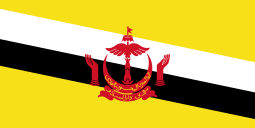
Back Vlag van Broenei Afrikaans علم بروناي Arabic Bruney bayrağı Azerbaijani Kobér Brunéi BAN Bandera kan Brunei BCL Сцяг Брунея Byelorussian Сьцяг Брунэю BE-X-OLD Национално знаме на Бруней Bulgarian ব্রুনাইয়ের জাতীয় পতাকা Bengali/Bangla ব্রুনাইর ফিরালহান BPY
 | |
| Use | Civil and state flag, civil ensign |
|---|---|
| Proportion | 1:2 |
| Adopted | 29 September 1959 |
| Design | A centered red crest of Brunei on a yellow field cut by black and white diagonal stripes (parallelograms). |
| Designed by | Yura Halim |

The flag of Brunei has a centered emblem of Brunei on a yellow field cut by black and white diagonal stripes (parallelograms at an angle). The yellow field represents the sultan of Brunei. The red crest consists of a crescent facing upwards, joined with a parasol, with hands on the sides.
In Southeast Asia, yellow is traditionally the color of royalty, and the royal standards of Malaysia and Thailand, and the flag of Sarawak, along with the presidential flag of Indonesia, all use a yellow field as well. The crescent symbolizes Islam, the parasol symbolizes monarchy, and the hands at the side symbolize the benevolence of the government. The black and white stripes represent Brunei's chief ministers[1] who were once joint-regents and then – after the sultan came of age – senior advisors: the Pengiran Bendahara (First Minister, symbolised by a slightly thicker white stripe) and the Pengiran Pemancha (Second Minister, governing foreign affairs, symbolised by black), with the white stripe being roughly 12% wider than the black one.[2][3]
On the crescent is the national motto of Brunei in Arabic: الدائمون المحسنون بالهدى; Ad-dāʾimūna al-muḥsinūna bi-l-hudā, meaning "Always render service with God's guidance".
Below this is a banner inscribed with the name of the country in Jawi: بروني دارالسلام; Brunei Darussalam, which means ‘Brunei, the Abode of Peace’
It is one of the few national flags incorporating a diagonal line, with other examples including the DR Congo, Tanzania, Namibia, and Trinidad and Tobago.
- ^ The National Geographic Magazine. National Geographic Society. 1935. p. 384.
- ^ The Flag Bulletin. Flag Research Center. 1984. p. 76.
- ^ Annual Report: Brunei. H.M. Stationery Office. 1946. p. 91.